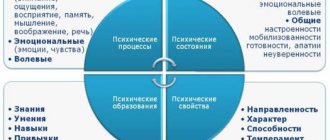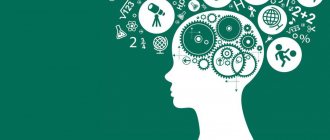Neuropsychology is a scientific field that was created on the border of neuroscience and psychology, studying the functioning of brain structures and their connection with mental processes and the behavior of living beings. Practical neuropsychology is used in research organizations that engage in clinical research, is used in judicial and investigative institutions, and in specialized clinics with the direction of clinical neuropsychology.
Practical neuropsychology is used in solving problems of medical psychology: diagnosis and rehabilitation. The clinical and theoretical components of neuropsychology operate in inextricable unity, under the initial conditions of the formation and development of neuropsychology.
Practical neuropsychology is at the stage of development, its main directions are determined by the expansion of the scope of application of the method of syndromic neuropsychological activity to the diagnosis of such categories of patients in which mental dysfunctions are less pronounced than with tumors and are more diffuse in their manifestation.
At the same time, neuropsychological qualification of the structure of mental disorders requires a systematic description of syndromic diagnostic data, containing what has just entered into practice, but has not yet been covered in previously published fundamental research.
Nowadays, such a direction of psychology as the neuropsychology of individual differences is beginning to actively develop, it is also called differential neuropsychology. This branch studies the brain organization of mental processes and the states of healthy individuals, based on the methodological and theoretical achievements of neuropsychological science. The relevance of the method of neuropsychological analysis of mental functions in healthy individuals is determined by practical and theoretical information.
The main theoretical problem arising in the field of neuropsychology is the need to answer the question of the possibility of extending general neuropsychological ideas about the cerebral organization of the psyche, which developed during the study of the consequences of local brain lesions, to the study of the cerebral mechanisms of the psyche of healthy individuals.
Subject, tasks, methods of neuropsychology
Neuropsychology is a branch of psychology that studies the brain mechanisms of higher mental functions and their connection with brain systems.
The subject of neuropsychology is brain structures involved in mental processes, emotional states and personal characteristics based on local brain lesions.
The object of neuropsychology is the brain of a sick person, damaged as a result of injuries, hemorrhages, cancerous tumors, and hereditary anomalies.
Neuropsychology was formed due to the demands of practice and the need to diagnose local brain lesions and restore impaired mental functions.
E.Yu. Balashova, B.A. Arkhipov, L.S. Tsvetkova and others. The validity of this statement is confirmed by the popularity it enjoys among psychologists, speech therapists, child neurologists and development teachers [1].
Consciousness.
Pseudo-blindness is just one of the types of consciousness disorders that occur when the brain is damaged. A disorder of “reflective self-awareness” (i.e., understanding oneself, including awareness of one’s own image and analysis of one’s psyche and actions) occurs due to damage to the parietal regions. In this case, patients “ignore” the part of their body on the side opposite the lesion. For example, a patient unsuccessfully tries to sit up in bed, but only gets tangled in the sheet. When it is pointed out to her that her hand is hindering her movement, she exclaims: “Oh, someone’s hand!” When they showed her that it was her hand, she was surprised and embarrassed - the patient did not perceive this hand as her own. Observing a dumb animal, we probably would not notice any deviations: its behavior in relation to the surrounding world would not be changed. Animal behavior is controlled by simpler forms of consciousness. A cat jumping up on a coffee table is definitely guided by some kind of consciousness. But imagine that your neighbor suddenly commits the same act, and when asked “why?” He replies that he doesn’t know, he just wanted to climb onto the table. It is later revealed that he was hypnotized and, while in hypnosis, was told to climb onto a coffee table. Like the cat, this man lacked reflective self-awareness, but unlike her, he could express it in words!
Hypnosis induces a different, alternative state of consciousness. Typically, this condition occurs when we fall asleep and dreams are difficult or even impossible to remember when we wake up. Different states of consciousness have their own specifics: what we experience in one is often impossible in another. When we are depressed, everything around us seems hopeless; when high spirits arise, we can only be surprised that something could shake our optimism. Drugs that act on the brain are capable of altering the state of consciousness, which is why they are called psychoactive or psychotropic. The applied branch of neuropsychology - neuropsychopharmacology - has achieved great success in studying the connection between various chemical processes occurring in the brain and changes in mood and state of consciousness.
However, it is true not only that the content of consciousness is determined by its state, but also the opposite. For example, the smell of bread from a bakery “awakens” your appetite. This connection is mediated by attentional processes. The state and content of consciousness, as well as the processes of attention that connect them, allow animals to successfully adapt to changes in the surrounding world that occur throughout their lives. What is the role of reflective self-awareness in the structure of human existence? Associated with reflective consciousness is the search for identity, the separation of the perceiving subject from what he perceives. Reflective consciousness is also associated with the search for community with other people - that community that allows individual consciousness to go beyond its limits. With reflection comes conscience; the word “conscience” itself in a number of languages has the same root as the word consciousness. These aspects of consciousness constitute the highest value of human existence and although associated with a specific physical system, the brain, which is similar to the brain of highly organized animals, the emergence and development of these forms of consciousness, according to many, is more difficult to explain from the perspective of evolutionary theory than the development of other, more “ biological" traits.
Neuropsychology methods
There are 2 groups of methods:
I. The first group of methods (scientific) - comparative - anatomical, irritation and destruction.
– The comparative anatomical research method makes it possible to clarify the dependence of the ways of life and behavior of animals on the structural features of their nervous system; with the help of the method, the principles of brain function, as well as the structure of the cerebral cortex, were clarified.
– The stimulation method involves analyzing the characteristics of the HMF when exposed to the brain. There are: direct stimulation, indirect stimulation and stimulation of individual neurons.
1. The method of direct stimulation is a direct impact on individual areas of the cortex using electric current or mechanical, chemical stimuli (For example: in 1871, Fritsch and Gitzik thus identified the motor zones of the cortex in dogs, C. Sherington (1903) conducted experiments on monkeys, V. Penfield was the first to use this method on humans (1945).
However, the method has limitations in humans. Therefore, the method of indirect stimulation appears.
2. The method of indirect stimulation or indirect stimulation of the cortex - reveals changes in the electrical activity of parts of the brain under the influence of various factors (for example: the method of evoked potentials of EP, when in response to a certain impact changes in rhythms are recorded in the spectrum of the electroencephalogram; microelectrode method - implantation of electrodes into neurons brain to identify their activity under various influences).
3. The method of destruction (or switching off) - involves the destruction of a certain area of the animal’s brain and observation of the characteristics of its behavior; in humans, the method is applicable during neurosurgical operations and brain injuries.
There are: irreversible disorders (surgical removal of certain parts of the brain, the method of cutting the commissures of the brain, proposed by R. Sperry), in which the function is completely lost, and reversible disorders, which are associated with the temporary shutdown of a separate part of the brain with subsequent restoration of functions: cooling below 25 degrees leads to the cessation of neuronal activity (for example: the Wada method, which involves injecting a special drug into the carotid artery and turning off the corresponding hemisphere of the brain).
II. The second group of methods (practical methods) are used by psychologists, speech therapists, child neurologists, and teachers.
(Within the framework of neuropsychology, there is also a section of neurorehabilitation . The main developments in this area are being carried out at the Moscow Center for Speech Pathology and Neurorehabilitation under the scientific guidance of Prof. M. Shklovsky. The main task of neurorehabilitation is the development of methods for restoring impaired HMF, differentiated in relation to the acute and long-term stages of the disease. The combination of methods used constitutes a comprehensive system of neurorehabilitation aimed at restoring the motor and analytical spheres, speech and other types of higher mental activity, as well as the social status of the patient.)
In the second group of methods, there are 3 approaches:
1️⃣. The method of syndromic analysis or “ battery of Luriev methods proposed by A.R. Luria (the founder of neuropsychology in Russia) .
A. R. Luria selected tests that allow one to assess the condition of all the main HMFs (according to their parameters). These techniques evaluate the brain structures that support mental processes, which makes it possible to determine the area of brain damage. The proposed method is based on a systematic approach and qualitative analysis of defects in cognitive processes and personal characteristics (speech, thinking, writing, counting, memory), voluntary movements and actions.
Personality.
Each of us makes sense of life in our own way, and this meaning is mediated by processes that bring past experiences into line with the present. Such processes relate to the function of the limbic system, which ensures the adequacy of behavior. The limbic system is closely connected with other systems formed by the midline structures of the brain. Neurons of the midline and limbic structures have an affinity for many chemicals. They not only bind specific chemicals, but also secrete some of them.
Neurochemistry has just begun to study the diverse chemical mediators acting in the midline and limbic structures. But much is already known; Let's list the main body functions regulated by the midline structures (starting from the anterior sections): body temperature, sexual activity (sex hormones), stress response (adrenal hormones), thirst (water content in the body), appetite (blood sugar), feeling of comfort or pain (endorphin levels), sleep and calm (serotonin), dreams (norepinephrine), breathing and cardiovascular activity (carbon dioxide levels in the blood). Certain limbic structures modulate such somatic functions, while others influence this modulatory link depending on the information received through sensory channels. On the other hand, limbic structures influence the sensory and motor cortex, thus influencing our perception and mode of action.
The posterior parts of the frontal lobes are especially closely connected to the limbic system. Interacting with nearby motor zones, as well as with other zones of the convex (convex) surface of the hemispheres, the posterior parts of the frontal cortex influence their activity, determining the adequacy of behavior. When this area is damaged, depending on the location of the lesion, mental functions such as the ability to plan, logically think, and highlight the main thing are severely disrupted. The identification of such connections, bridging the traditional gap between the natural sciences, on the one hand, and the study of the subjective sphere - thinking, emotions, aspirations - on the other, is the subject of neuropsychology.
Luriev method of neuropsychological research
The “Battery of Luriev Methods” includes:
1) a formal description of the patient, his medical history and the results of various laboratory and instrumental examinations (EEG, biochemistry, etc.);
2) a general description of the patient’s mental status – state of consciousness, ability to navigate place and time, level of criticism and emotional background;
3) studies of voluntary and involuntary attention;
4) studies of emotional reactions based on the patient’s complaints, according to his assessment of faces in photographs, plot paintings;
5) studies of visual gnosis (perception) - using real objects, contour images, when presenting various colors, faces, letters and numbers;
6) studies of somatosensory gnosis using tests of recognition of objects by touch, by touch;
7) studies of auditory gnosis when recognizing melodies, localizing a sound source, and repeating rhythms;
 studies of movements and actions when performing the latter according to instructions, when setting poses;
studies of movements and actions when performing the latter according to instructions, when setting poses;
9) speech research - through conversation, repetition of sounds and words, naming objects, understanding speech and rarely encountered words, logical and grammatical structures;
10) studies of writing - letters, words and phrases;
11) reading studies - letters, meaningless and meaningful phrases and misspelled words;
12) memory studies - words, pictures, stories;
13) research into the counting system;
14) research into intellectual processes - understanding stories, solving problems, correct endings of phrases, understanding analogies and opposites, figurative and general meaning, ability to classify.
2️⃣. Psychometric (North American) - a battery of tests is used, the results are assessed on a standard scale. For example: Luria-Nebraska Battery, Wechsler Intelligence Scale for Adults, etc.
3️⃣. Individually oriented (British School of Neuropsychology) – Initially, screening (selection, triage) studies are carried out. Then an individual set of tests is generated.
A special area of application of neuropsychological methods is the problem of school maladaptation (tests for the study of sensations - visual, auditory, tactile; study of cerebellar function, lateral dominance, etc., for academic performance, learning ability, intelligence, etc.). Using the method of syndromic analysis, it is possible to determine the presence or absence of brain dysfunctions in children with learning difficulties, to reveal the mechanisms underlying these difficulties, and to understand the primary defect that determined their occurrence.
Clinical psychology
Many people think that the beginning of this approach coincided with Lightner Witmer, who founded the first psychological clinic in 1896. This new chapter strengthened its position with the founding of the American Psychological Association.
The original goal of clinical psychology was to identify the traits or internal factors that lead people to develop psychopathological conditions. Clinical psychology studies other factors that control a person's behavior and have any influence, and does not study only the human condition. This psychological approach originally emerged as an “abnormal” approach. As a result, the area of interest of this study expanded around treatment and explanation of the situation.
Over time, the prevention of mental illness has become one of the outcomes that the healing process strives for as the main goal of clinical psychology. As a result, psychologists began working to identify methods that would work to prevent the development of various pathologies by introducing healthy mental habits.
Similarly, clinical psychologists began to use other methods known as “reference therapy.” These techniques were aimed at teaching people how to effectively solve problems related to situations that might arise in their daily lives. As a result, emotional support also became part of this practice.
Main directions of neuropsychology
The main areas of neuropsychology are the following:
1. Clinical neuropsychology , which studies patients with local brain lesions.
The main goal is to study neuropsychological syndromes in local brain lesions. Research in this area is of great practical importance for diagnosis, preparation of a psychological report on the possibility of treatment, recovery and prognosis of the future fate of patients. The main method is the method of clinical neuropsychological research. Currently, clinical neuropsychology is studying syndromes associated with damage to the right hemisphere of the brain, defects in interhemispheric interaction, and disruption of deep brain structures. Further development of this area is associated with the development of modern methods for diagnosing local brain lesions.
2. Experimental neuropsychology.
The main task is the experimental study of various forms of disturbances of mental processes in local brain lesions. Thanks to the work of A.R. Luria with students, memory and speech have been most studied. He created a classification of aphasias and expanded ideas about the organization of memory.
Currently, studies are being conducted on the characteristics of disturbances in cognitive processes and the emotional-personal sphere in brain lesions of different locations.
3. Rehabilitation neuropsychology.
The main goal of this direction is the restoration of HMF in case of local brain lesions. The principles and methods of speech restoration have been most developed. Developments in this area began during the Great Patriotic War (A. R. Luria, A. V. Zaporozhets, B. G. Ananyev, A. N. Leontyev). Scientifically based methods for restoring HMF have been proposed, based on the central proposition that complex mental function can be restored by restructuring the functional system. As a result, the damaged function begins to work with the help of a new set of mental means, which implies its new brain organization.
Currently, the scope of activity of neuropsychologists includes patients who have suffered a stroke, various types of brain injuries, etc. New methods of speech restoration, audiovisual methods, group methods, and influence on the emotional and personal sphere of patients are being developed.
The main developments in this area are being carried out at the Moscow Center for Speech Pathology and Neurorehabilitation under the leadership of V.M. Shklovsky.
4. Environmental neuropsychology evaluates the influence of various unfavorable environmental factors on the state of mental functions and on the emotional and personal sphere from the perspective of neuropsychology.
The field began to develop shortly after the Chernobyl disaster, and in the context of a constantly deteriorating environment, this research is becoming increasingly relevant.
5. Developmental neuropsychology . The task of developmental neuropsychology is to identify patterns of brain development.
In recent years, childhood neuropsychology has emerged as an independent field. This is a new area of neuropsychology that studies the specifics of mental dysfunction in local brain lesions in children.
Much attention is paid to the neuropsychological analysis of learning difficulties in children of primary school age in connection with brain dysfunctions.
6. Psychophysiological direction is a direction whose task is to study the physiological mechanisms of disorders of higher mental functions. It develops in close connection with psychophysiology, making extensive use of its research methods (electroencephalography, oculography, myography, etc.).
7. The diagnostic direction is the practical application of various neuropsychological methods to determine the area of brain damage and the dynamics of the state of higher mental functions in the pre- and postoperative period.
These methods were developed by A. R. Luria on the material of traumatic and tumor lesions of the brain, but they are also used in the stroke clinic. They are increasingly used to assess the dynamics of the state of HMF in the pre- and postoperative periods, since neuropsychological syndromes appear earlier and disappear later than any other symptoms. In addition, these methods are used to monitor drug therapy in patients who have undergone neurosurgical operations.
8. The rehabilitation direction of the practical application of neuropsychological methods is associated with the restoration of impaired HMF, speech, intellectual and mnestic activity.
Currently, a neuropsychological approach to the study of a healthy person is increasingly being developed, for example, the study of interhemispheric asymmetry.
Founder of Russian neuropsychology -
Alexander Romanovich Luria.
Luria Alexander Romanovich, Soviet psychologist and neuropathologist, one of the founders of neuropsychology. Doctor of Pedagogical Sciences (1937), Doctor of Medical Sciences (1943), Professor (1944), full member of the Academy of Pedagogical Sciences of the RSFSR. Photo: i.pinimg.com
Speech.
Man has the ability to convey messages through a set of signals with which he can express what he thinks and feels and evoke similar thoughts and feelings in other people. Signals of this kind include natural languages, mathematics, and music. For most people raised in Western culture, the hemispheres of the brain play different roles in processing these signals. The main difference is that the left hemisphere is specialized for language functions. Even in Ancient Greece, they knew about the specialization of the hemispheres: Hippocrates and Galen noted that damage to the left half of the brain leads to speech impairment. In the modern era, this fact was rediscovered by P. Broca, who, however, did not quite correctly determine the location of the speech zone. The area of the brain that, when damaged, causes speech disorders, actually lies behind the area indicated by Broca. The boundaries of this area were clarified by K. Wernicke, who, in addition, identified two types of speech disorders. The first type, associated with a violation of speech expression, was called Broca's aphasia, since it occurs when the anterior parts of the speech zone are damaged near the area marked by Broca. This type of aphasia is often characterized by a telegraphic style—the patient uses only “content words” to denote events or objects. Another type of aphasia, now called Wernicke's aphasia, is characterized by impaired speech perception. Patients with Wernicke's aphasia are often verbose, their speech at first glance seems meaningful, but after listening, one can understand that the patient constructs seemingly correct sentences from a completely meaningless set of words (see also AFASIA).
With more extensive brain damage, other, more severe types of aphasia occur. In addition, there are special types of speech disorders associated with damage to neural connections and disconnection of various brain systems responsible not only for speech itself, but also for its meaning, as well as for the effect that it is supposed to produce. Language as a means of communication includes several brain systems, and speech itself is only one of them.
By exploring the relationships between the brain, speech, and language, neuropsychologists have learned a lot about the organization of the brain as a whole. The fact that computer models of brain networks based on parallel data processing turned out to be capable of learning speech led to the conclusion that the brain should also be structured as a combination of individual systems, which, in turn, consist of networks that carry out parallel processing of information . The systems are united by branched distant conductors (nerve tracts) connecting the sense organs with the brain, the brain with the muscles, and individual parts of the brain with each other. The networks themselves consist of short microconnections formed by branches of nerve fibers. The processes of learning and memory are based on the properties of networks, and the systemic organization gives stability to the functioning of the brain.
After brain damage, such as a stroke, its organization, even at the systems level, can be transformed to a certain extent. If, as a result of practice and training, a sufficient number of new microconnections are formed, they can suppress the old system, carrying out the process of reorganization. Perhaps this is how our knowledge and aspirations are reorganized from time to time when accumulated experience comes into conflict with the system within which it is organized. Reorganization can be gradual or rapid, such as when we suddenly change our views.
Main directions of scientific research in neuropsychology
– Cultural-historical concept of mental development, participated in the creation of the theory of activity. On this basis, he developed the idea of the systemic structure of higher mental functions, their variability, plasticity, emphasizing the lifetime nature of their formation, their implementation in various types of activities.
– Investigated the relationship between heredity and upbringing in mental development. Using the twin method traditionally used for this purpose, he made significant changes to it, conducting an experimental genetic study of the development of children in conditions of the targeted formation of mental functions in one of the twins. Showed that somatic symptoms are largely determined genetically, elementary mental functions (for example, visual memory) - to a lesser extent. And for the formation of higher mental processes (conceptual thinking, meaningful perception, etc.), the conditions of education are decisive.
– In the field of defectology, he developed objective methods for studying abnormal children. The results of a comprehensive clinical and physiological study of children with various forms of mental retardation served as the basis for their classification, which is important for pedagogical and medical practice.
– Created a new direction - neuropsychology, which has now become a special branch of psychological science and has received international recognition. The development of neuropsychology began with studies of brain mechanisms in patients with local brain damage as a result of injury.
– Developed a theory of localization of higher mental functions,
– formulated the basic principles of dynamic localization of mental processes,
– created a classification of aphasic disorders and described previously unknown forms of speech disorders,
– studied the role of the frontal lobes of the brain in the regulation of mental processes,
– studied the brain mechanisms of memory.
Learning and memory.
The ability to remember is inherent in our entire body: muscles become stronger during training; the immune system has a memory that provides protection against repeated invasions of microorganisms; the rhythm of breathing and cardiac activity, digestive cycles are also established in accordance with experience. But remembering your grandma or your prom or your multiplication tables or your first date requires a properly functioning brain.
The brain contains enough cells to store a huge store of knowledge. More importantly, however, each brain cell constantly receives information from numerous branches of nerve fibers. Most neuropsychologists believe that the accumulation of experience occurs at the level of contacts (synapses) between the branches of nerve fibers, although this has not been conclusively proven. It is known that there are myriads of such connections in the newborn brain. During lifelong learning processes, some of them atrophy and disappear, while in others active cell membranes thicken. This shows that the connections made by nerves become increasingly selective over time. As a result, if a previously occurring event is repeated, the same network of interacting brain cells is activated as the first time, and this is “remembering” the original experience. One would expect that damage to the system of neural connections (for example, during a stroke) or its selective removal under experimental conditions would be accompanied by the loss of strictly defined memory traces. But this doesn't happen. A woman who has had a stroke and retains the ability to recognize her children does not need to ask her husband who he is. Memory is a holistic function, which is much more difficult to explain.
Two discoveries have allowed neuropsychologists to at least chart a path toward solving this problem. The first was done by mathematicians and led to the advent of holography. The hologram stores information in a unique way. Unlike conventional photography, in which the image is recreated on photographic film, a hologram consists of interference points of light waves of various shapes reflected from an object. At such points, interacting waves either enhance or cancel each other. From a mathematical point of view, a photographic image and a hologram represent a reversible transformation of each other, i.e. an image can be transformed into a hologram, and a hologram into an image.
The second discovery is more of an invention than a discovery. Scientists have found a way to simulate the connections of brain cells using computer programs. Special programs have been developed that can learn anything from musical phrases to language. Of particular interest was the fact that when analyzing such programs, it was impossible to localize the memorization of individual musical phrases or words in individual parts of these networks. Storage turned out to be distributed. Therefore, information to be remembered is first dissected and stored in a delocalized manner. From a mathematical point of view, these computer programs are based on the same reversible transformations as those that create holography. By recording the activity of single brain cells in the visual cortex of monkeys and cats, scientists found that information processing in the visual system can be described using the same mathematical formulas as holography, as well as computer programs based on parallel processing of data.
Experimental psychology and neuropsychology distinguish several types of learning and memory. One of them, sensory memory, is closely related to the corresponding sensory systems. In such memory, information is stored from several seconds to several minutes, less often hours. Another type of learning and memory relates to skill acquisition; it is disrupted when the motor systems of the brain are damaged. Semantic, or referential, memory is organized like a dictionary and is associated with the activity of the occipital regions of the cerebral hemispheres. The frontal and limbic regions provide memory for events. This type of memory links together facts that are perceived as a single event, the beginning and end of which are marked by an indicative reaction. Memory for events is close to the so-called. "working" memory, which is responsible for what needs to be done on a daily basis.
Symptoms, syndromes and factors in neuropsychology
A neuropsychological symptom is a violation of mental function that occurs with local damage to the brain, due to pathological, traumatic causes, leading to local changes in brain function.
Neuropsychological syndrome is a natural combination of neuropsychological symptoms caused by damage (loss) of a certain factor (or several factors).
Neuropsychological factor is a structural and functional unit of the brain, characterized by a certain principle of physiological activity, the violation of which leads to the appearance of a neuropsychological syndrome.
Tags: neuropsychology
Neuropsychological syndromes in local brain lesions
Neuropsychological syndromes, their structure and the isolation of the syndrome-forming radical have been developed and described in relation to lesions of the left hemisphere of the brain, and syndromes of lesions of the structures of the right hemisphere of the brain require further development.
Data on neuropsychological symptoms that are associated with damage to these particular brain areas are already available, and make it possible to carry out neuropsychological diagnostics. True, the interpretation of these symptoms has not received complete theoretical understanding.
This requires further development of ideas about what are the features of the structural and functional organization of the brain zones of the right hemisphere. We need a new approach to the analysis of factors in the structure of mental reflection.
Today, a more systematic description of the available syndromic diagnostic data is required, including new data that has already entered into practice, but has not received wide coverage in previously published fundamental works.








